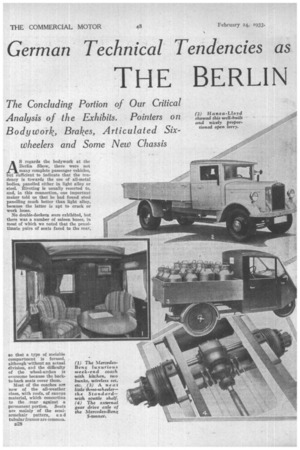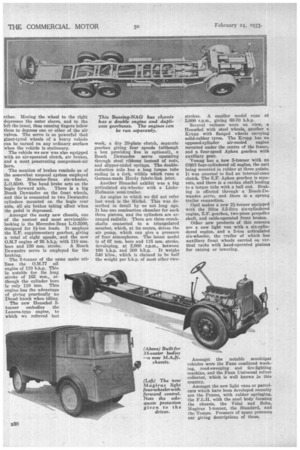German Technical Tendencies as Revealed by
Page 42

Page 43

Page 44

If you've noticed an error in this article please click here to report it so we can fix it.
THE BERLIN
SHOW
S regards the bodywork at the Berlin Show, there were not many complete passenger vehicles, but sufficient to indicate that the tendency is towards the use of all-metal bodies, panelled either in light alloy or steel. Riveting is usually resorted to, and, in this connection, one important maker told us that he had found steel panelling much better than light alloy, because the latter is apt to crack or work loose.
No double-deckers were exhibited, but there was a number of saloon buses, in most of which we noted that the Penultimate pairs of seats faced to the rear, so that a type of sociable compartment is formed, although withoutan actual division, and the difficulty of the wheel-arches is overcome because the backto-back seats cover them.
Most of the coaches are now of the all-weather class, with roofs, of canvas material, which concertina to the rear against a permanent portion. Seats are mainly of the semiarmchair pattern, a n d tubular frames are common.
B28 In the Gaubschat body the upholstery is very thin, but is mounted on an interlaced web of light springs having the appearance of chain mail.
A most elaborate body was the weekend coach, shown by Mercedes-Benz. This has adjustable armchair seats all around an oval table, which is capable of being lengthened. One rear corner is occupied by a well-equipped kitchen with double oil stove, refrigerator, cabinets for glasses and crockery, and a wash-basin; immediately next to this, close to the rear door, is a wireless set, the speaker of which is mounted on the front panelling of the kitchen. The other rear corner has a stand and drainer for umbrellas and coats. The row of three seats behind the driver's position can be turned into two bunks, and part of the cab is divided off by rails, so that ample luggage can be carried; there is also a tip-up seat in this part. The folding roof is operated by
a handle on the driver's partition. In this case the body is of all-steel, riveted construction.
In a steel-bodied 33-seater bus shown by the same company, the roof is operated by means of an electric motor. Opel showed a combination limousine in which the rear seating is removable, and access for loading with goods given by a large rear door. 1Vb noted one cattle body, in which a portion of the side and the whole back hinged down to form ramps. This was on a Phanomen Granit chassis.
The Krupp new 24-seater all-weather bus with cloth roof, handle-operated, was shown with the new 60 b.h.p. aircooled, four-cylindered engine, but the 50 b.h.p. oil engine of the same type is optional.
Matra had a most completely equipped workshop lorry body mounted on an Opel Blitz chassis.
The Hansa-Lloyd Goliath chassis was
shown in several forms and with different classes of bodywork. Some examples are made with one wheel at the front and two behind; in others, this principle is reversed. The most primitive seating consists of either one or two saddles mounted on a casing covering the engine and rear wheel. Other types have complete van bodies with comfortable cabs. Then there is a fourwheeler to carry loads up to a ton and provided with a 15 b.h.p. air-cooled twocylindered, two-stroke-cycle motor. Incidentally, the one-tonner staged had its cab door at the front instead of the side ; this might cause some difficulty in a queue of vehicles. It makes quite a capacious machine when provided with forward control.
The largest Goliath model has the two rear wheels carried on four quarterelliptic springs, which take the place of an axle, and cardan drive is provided to each rear wheel from a central differential. The wheels are of pressed steel, with large holes cut out for lightness, and the front wheel is mounted on a single tubular bracket which curves away from the forward portion of the wheel to enable it to turn for steering.
A. fine Mercedes-Benz 29-seater was demonstrated outside the Show. In this model all the seats face forward, but what is of chief interest in this machine is that it is equipped with an eightcylindered, supercharged engine similar to that used in the big Mercedes racing cars. It develops 150 b.h.p. normally, which is raised to 200 b.h.p. with the supercharger in use. The maximum speed is 120 kiloms. per hour, which is just 75 m.p.h.
A few of the buses have folding doors, other doors are of the sliding type, and there are one or two examples of the one-man-operated pattern controlled from the driver's seat.
Knorr-Bremse showed a compressedair-operated sliding door, for which ordinary bell pushes are used, one push opening the door and the second closing it ; the latter is intended to be used only by the conductor.
While referring to this concern, it may be interesting to mention its compressed-air servo for steering heavy vehicles. Two cylinders are used, one at each side. The means for operation was illustrated in our issue for last week. Just below the steering wheel is a pin resting on the bevelled edges of two sleeves—one mounted within the
other. Moving the wheel to the right depresses the outer sleeve, and to the left the inner, thus causing fingers below them to depress one or other of the air valves. The servo is so powerful that giant-tyred wheels of a heavy vehicle can be turned on any ordinary surface when the vehicle is stationary.
The vehicle we saw was also equipped with an air-operated clutch, air brakes, and a most penetrating compressed-air horn.
The mention of brakes reminds us of the somewhat unusual system employed on the Mercedes-Benz six-wheeler, L.0.8500. The hand brake acts on the bogie forward axle. There is a big Bosch Dewandre on the front wheels, and this is connected to two Dewandre cylinders mounted on the bogie rear axle, all six brakes taking effect when the pedal is depressed.
Amongst the many new chassis, one of the neatest and most serviceablelooking is the Mercedes-Benz L.0.3500, designed for 3fr-ton loads. It employs the Z.F. supplementary gearbox giving a total of eight speeds, and the new 0.31.7 engine of 95 b.h.p. with 110 mm.
bore and 130 rum. stroke. A Bosch Dewandre servo is employed for the braking.
The 5-tonner of the same make utilizes the 0.M.77 oil engine of 110 b.h.p. This is notable for its long stroke of 165 mm., although the cylinder bore is only 110 mm. This engine has the advantage of giving practically no Diesel knock when idling.
The new Henschel 5tanner embodies the Lanova-type engine, to which we referred last week, a dry 20-plate clutch, separate gearbox giving four speeds (although a box providing five is optional), a Bosch Dewandre servo operating through steel ribbons instead of rods, and slipper-ended springs. The doublereduction axle has a long torque tube ending in a fork, within which runs a German-made Hardy fabric-link joint.
Another Henschel exhibit was a big articulated six-wheeler with a LinkeHofmann semi-trailer.
An engine to which we did not refer last week is the Michel. This was described in detail by us not long ago. It has one combustion chamber for each three pistons, and the cylinders are arranged radially. There are three crankshafts connected to a triangulated member, which, at its centre, drives the air pump, which can give a pressure of four atmospheres. The latest model is of 67 mm. bore and 116 mm. stroke, developing, at 2,000 ram., between 160 b.h.p. and 200 b.b.p. It weighs 540 kilos., which is claimed to be half the weight per b.h.p. of most other two
strokes. A smaller model runs at 2,600 r.p.m., giving 60-70 b.h.p.
Several railcars were on view, a Henschel with steel wheels, another a Krupp with flanged wheels carrying solid-rubber tyres. The Krupp has an opposed-cylinder air-cooled engine mounted under the centre of the frame, and a four-speed Aphon gearbox with auxiliary gear.
Vomag has a new 5-tonner with an OMO four-cylindered oil engine, the unit being mounted in rubber at three points. It was unusual to find an internal-cone clutch. The Z.F. Aphon gearbox is separate, and there is a cardan shaft leading to a torque tube with a ball end. Braking is effected through a Bosch-Dewandre servo, and there is a sprung trailer connection.
Opel makes a new 21-tonner equipped with the Blitz 3.5-litre six-cylindered engine, Z.F. gearbox, two-piece propeller shaft, and cable-operated front brakes.
Other new products of this concern are a new light van with a six-cylindered engine, and a 5-ton articulated six-wheeler, the trailer of which has auxiliary front wheels carried on vertical racks with hand-operated pinions for raising or lowering.
Amongst the notable municipal vehicles were the Faun combined washing, road-sweeping and fire-fighting marhine, and the Faun Universal refuse collector, which is well known in this country. Amongst the new light vans or parcelcars which have been developed recently are the Framo, with rubber springing, the F.L.H. with the steel body forming the chassis, the Vidal and Sohn, Magirus 1-tonner, the Standard, and the Tempo. Pressure of space prevents our giving descriptions of these.




























































































